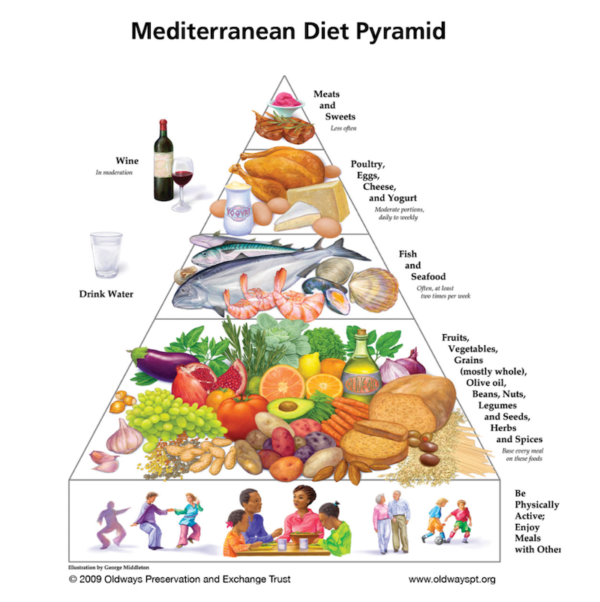
Editor’s Note: One of the things that has consumed me as it has so many of you was that during these pandemic times, I was determined not to see a weight gain of the “Covid 19”, but the lessened activity did raise a problem. I have been able to work closely with Catherine Kruppa on following a way of eating that is not so restrictive as many diets are, but healthy in a heart-friendly way, which has always been a priority to me! Also, as the Mediterranean and Italy, especially, and Greece are my favorite dining destinations, eating as they do, became my goal and it has worked for me and kept me very happy at the same time! Read below to learn more about this growing popular way of eating……..I give you The Mediterranean Diet.
From Catherine Kruppa: When we think about fad diets, our minds usually drift to restrictive, short-term diets like the Atkins diet, Whole 30, and more. However, there is one diet, more so an eating guideline, that has gained a lot of following in the last few years. It is linked to decreasing risk factors for cardiovascular disease, increasing healthy aging, and decreasing overall mortality. It is recognized by the Dietary Guidelines for Americans and the World Health Organization as a healthy eating plan and sustainable dietary pattern, respectively. Can you guess what we are talking about? If you guessed the Mediterranean Diet, you are right!
What is it?

The Mediterranean Diet focuses on the traditional diet of countries along the Mediterranean Sea. During the mid-20th century, Greece, Italy, and Crete had decreased rates of chronic disease and increased life span despite their access to healthcare. It was proposed that their diet was the main contributor to these health benefits, and this is now seen in current research. Studies consistently shows the effectiveness of this diet on healthy aging, reduced risk of cardiovascular disease, improved cognitive function. Now that you have learned a little bit about the history of this diet, let’s break down the diet.

The general guidelines
This diet is mostly plant-based, focusing on vegetables, fruit, whole-grains, beans, nuts, seeds, herbs, and olive oil. Although animal protein sources are allowed (preferably fish and seafood), they are typically eaten in smaller quantities. Unlike other diets, the Mediterranean diet does not give portion recommendations, it is simply a guideline for individuals to use to meet their dietary needs based on body size and physical activity.

- Focus on fruits and vegetables daily
- Aim for 7-10 servings per day
- Choose whole grain breads, pastas, and cereals
- Protein sources
- Fish & seafood: 2 times per week
- Poultry & eggs: few times a week (or daily in small portions)
- Dairy: low-fat yogurt a few times a week in small amounts
- Red meat: few times per month
- Focus on healthy added fats (like olive oil) and foods with natural healthy fats (avocados, nuts, oily fish)
- Choose water as the main beverage, but allow wine in moderation (1 glass/day for women, 1-2 glasses/day for men)
- Experiment with spices to decrease the need for salt
- Exercise daily and focus on activities that are enjoyable
- Share meals with family and friends
The Wine clause

Yes, red wine, in moderation, is a part of the Mediterranean diet. Red wine contains antioxidants and anti-inflammatory compounds that are beneficial to overall health. The moderation aspect is key, so try to stay below 1-2 glasses per day.
*These general recommendations can be used as a guide to build your own individual plan based on your likes and eating habits! If you would like individual help with your nutrition and wellness, we would love to help you with a personal plan. Email us at info@adviceforeating.com

The solution, says the jungle-dweller, is his new book, The Italian Diet, published this month. It isn’t a manual for how to shrink your trouser size in a month. Instead, those who adhere to its short list of recipes can hope to shed around a pound a week – the plus point being that they stand a chance of not putting it back on. It’s not a question of cutting down on meals and hitting the gym seven times a week; it’s more about adhering to the Italian “way of life”. While the book suggests that living like an Italian – enjoying the experience of filling your shopping bag with the best ingredients, for example – will revolutionise your life, benefits are more likely to be seen in D’Acampo’s replacement of traditional ingredients, such as the mascarpone cheese in tiramisu, with lower-fat alternatives such as greek yogurt. In that recipe, for example, he hopes to halve our calorie intake, from around 400 down to 200 per serving.
Hi Rozie aka My Red Glasses – just want to say hi and love to read your newsletter. As a descendant of Lebanese heritage, we’re practically kissing cousins. LOVE Mediterranean food, and am lucky to live close by one of my favorite restaurants, known for their cabbage rolls, Foods from Afar.
Hugs,
Billie
Hi Billie, thank you so much for reaching out to me, I miss you so much and love hearing from you. I hope that all is well with you and your family. I think of you and our special days together at Foley’s oftne!! Love to you for a beautiful holiday! xo